Best Deep Learning Software
Best deep learning software for any educational system is neural designer, concentric market, clarifai organisation, h2o, and keras. It promotes machine learning and allows users to learn about many levels of abstraction and representation.



No Cost Personal Advisor
List of 20 Best Deep Learning Software
Emergents | 2024
Software by H2O.ai
H2O is a fully featured Artificial Intelligence Software designed to serve Agencies, SMEs. H2O provides end-to-end solutions designed for Windows. This online Artificial Intelligence system offers For Healthcare, Predictive Analytics at one place. Learn more about H2O
Explore various H2O features, compare the pricing plans, and unlock the potential of seamless operations by selecting the right software for your business.
Features
View all H2O Features- For Healthcare
- Client Management
- Alerts / Escalation
- Field Reporting
- Data Analysis
- Predictive Analytics
- Compliance Management
- Budget Management
H2O Caters to
- StartUps
- SMBs
- Agencies
- Enterprises
Contenders | 2024
Software by Keras
Keras is a fully featured Learning Management Software designed to serve Startups, Agencies. Keras provides end-to-end solutions designed for Windows. This online Learning Management system offers Convolutional Neural Networks, Document Classification, ML Algorithm Library, Model Training, Visualization at one place. Read Keras Reviews
Explore various Keras features, compare the pricing plans, and unlock the potential of seamless operations by selecting the right software for your business.
Features
View all Keras Features- Document Classification
- Visualization
- ML Algorithm Library
- Model Training
Keras Caters to
- StartUps
- SMBs
- Agencies
- Enterprises
Contenders | 2024
Build your neural network predictive models
Neural Designer is a machine learning software that offers Data Visualization, Predictive Analytics, Neural Network Modeling and Visualization at one place. Read Neural Designer Reviews
Explore various Neural Designer features, compare the pricing plans, and unlock the potential of seamless operations by selecting the right software for your business.
Features
View all Neural Designer Features- Visualization
- Statistical Analysis
- Neural Network Modeling
- Data Cleansing
- Predictive Analytics
- Data Visualization
- Analytics
- Fraud detection
Pricing
Small Annual Plan
$ 2495
Full Licence/Single User
Small Lifetime Plan
$ 6245
Full License/Single User
Medium Annual Plan
$ 4995
Full License/Single User
Neural Designer Caters to
- StartUps
- SMBs
- Agencies
- Enterprises
Contenders | 2024
Software by TensorFlow
TensorFlow is a fully featured Machine Learning Software designed to serve Enterprises, SMEs and StartUps. TensorFlow provides end-to-end solutions designed for Web App and Android. This online Machine Learning system offers Deep Learning, Model Training, Statistical / Mathematical Tools and Visualization at one place. Read TensorFlow Reviews
Explore various TensorFlow features, compare the pricing plans, and unlock the potential of seamless operations by selecting the right software for your business.
Features
View all TensorFlow Features- Model Training
- Deep Learning
- Visualization
- Statistical / Mathematical Tools
TensorFlow Caters to
- StartUps
- SMBs
- Agencies
- Enterprises
Contenders | 2024
Software by Otter.ai
Otter is a fully featured Productivity Management Software designed to serve SMEs, Startup, Agencies, Enterprises. Otter provides end-to-end solutions designed for Web App. This Productivity Management System offers File Sharing, Speech Recognition, AI/Machine Learning, Subtitles/Closed Captions, Natural Language Processing at one place. Read Otter Reviews
Explore various Otter features, compare the pricing plans, and unlock the potential of seamless operations by selecting the right software for your business.
Features
View all Otter Features- Annotations
- AI/Machine Learning
- Audio/video File Upload
- Collaboration Tools
- Subtitles/Closed Captions
- Speech Recognition
- Natural Language Processing
- File Sharing
Pricing
Basic
$ 0
Per Month
Pro
$ 17
Per Month
Business
$ 30
Per Month
Otter Caters to
- StartUps
- SMBs
- Agencies
- Enterprises
Emergents | 2024
Software by Wolfram
Wolfram Mathematica is a software used for internet of things that handles all facets of technical computing. It includes visualizations, machine learning, data science, and image processing. Plus, the system is continually expanding and is available for on-premise deployment. Learn more about Wolfram Mathematica
Explore various Wolfram Mathematica features, compare the pricing plans, and unlock the potential of seamless operations by selecting the right software for your business.
- Self-Learning
- Device management
- Visualization / Presentation
- Data Management
- Performance Management
- Work order management
- Application Development
Wolfram Mathematica Caters to
- StartUps
- SMBs
- Agencies
- Enterprises
Emergents | 2024
Software by MIPAR
MIPAR is a fully featured Digital Asset Management Software designed to serve SMEs, Agencies. MIPAR provides end-to-end solutions designed for Macintosh. This online Digital Asset Management system offers Search/Filter at one place. Learn more about MIPAR
Explore various MIPAR features, compare the pricing plans, and unlock the potential of seamless operations by selecting the right software for your business.
Features
View all MIPAR Features- Version Control
- Reporting/Analytics
- Workflow Management
- Approval Process Control
- Asset Management
- Search/Filter
- Change Management
MIPAR Caters to
- StartUps
- SMBs
- Agencies
- Enterprises
Emergents | 2024
Software by Deep Cognition
Deep Learning Studio is a fully featured Artificial Intelligence Software designed to serve Agencies, SMEs. Deep Learning Studio provides end-to-end solutions designed for Web App. This online Artificial Intelligence system offers Predictive Analytics, ML Algorithm Library, Model Training, Visualization at one place. Learn more about Deep Learning Studio
Explore various Deep Learning Studio features, compare the pricing plans, and unlock the potential of seamless operations by selecting the right software for your business.
- Dashboard
- Contact Management
- Visualization
- Profitability Analysis
- Document Management
- ML Algorithm Library
- Predictive Modeling
- Predictive Analytics
Deep Learning Studio Caters to
- StartUps
- SMBs
- Agencies
- Enterprises
Emergents | 2024
Software by Cognex Corporation
Cognex ViDi Suite is a fully featured Inventory Management Software designed to serve Agencies, Enterprises. Cognex ViDi Suite provides end-to-end solutions designed for Web App. This online Inventory Management system offers Document Classification, Image Segmentation, Self-Learning at one place. Learn more about Cognex ViDi Suite
Explore various Cognex ViDi Suite features, compare the pricing plans, and unlock the potential of seamless operations by selecting the right software for your business.
Features
View all Cognex ViDi Suite Features- Cash Management
- Payment Processing
- Self-Learning
- Order Management
- Import / Export Management
- Billing & Invoicing
- Document Classification
- Distribution Management
Cognex ViDi Suite Caters to
- StartUps
- SMBs
- Agencies
- Enterprises
Emergents | 2024
Software by DataRobot
DataRobot is a fully featured Machine Learning Software designed to serve SMEs, Agencies. DataRobot provides end-to-end solutions designed for Web App. This online Machine Learning system offers Model Training, Visualization, Neural Network Modeling, Image Segmentation, ML Algorithm Library at one place. Learn more about DataRobot
Explore various DataRobot features, compare the pricing plans, and unlock the potential of seamless operations by selecting the right software for your business.
Features
View all DataRobot Features- Predictive Modeling
- Neural Network Modeling
- Image Segmentation
- Templates
- ML Algorithm Library
- Model Training
- Deep Learning
- Visualization
DataRobot Caters to
- StartUps
- SMBs
- Agencies
- Enterprises
Emergents | 2024
Software by Brighter AI Technologies
Brighter AI is a fully featured Learning Management Software designed to serve SMEs, Agencies. Brighter AI provides end-to-end solutions designed for Web App. This online Learning Management system offers Visualization at one place. Learn more about Brighter AI
Explore various Brighter AI features, compare the pricing plans, and unlock the potential of seamless operations by selecting the right software for your business.
Features
View all Brighter AI Features- Admissions Management
- Account Management
- Alerts/Notifications
- Visualization
- Dashboard
- Contact Management
- Collaboration
Brighter AI Caters to
- StartUps
- SMBs
- Agencies
- Enterprises
Emergents | 2024
Software by Concentric
Concentric Market backed many established firms to simulate their market. It has a built-in capability to provide solutions related to marketing, industry, and product. It has a centralized platform to manage business operations and provide sales forecast and reports accurately. Learn more about Concentric Market
Explore various Concentric Market features, compare the pricing plans, and unlock the potential of seamless operations by selecting the right software for your business.
Features
View all Concentric Market Features- Data Blending
- Demand Forecasting
- Modeling & Simulation
- AI / Machine Learning
- Sentiment Analysis
Concentric Market Caters to
- StartUps
- SMBs
- Agencies
- Enterprises
Emergents | 2024
Software by DeepSearch
DEEP.assist is a fully featured Customer Service Software designed to serve Agencies, Startups. DEEP.assist provides end-to-end solutions designed for Windows. This online Customer Service system offers Knowledge Base, Text Analytics at one place. Learn more about DEEP.assist
Explore various DEEP.assist features, compare the pricing plans, and unlock the potential of seamless operations by selecting the right software for your business.
Features
View all DEEP.assist Features- Knowledge Base
- Text Analytics
DEEP.assist Caters to
- StartUps
- SMBs
- Agencies
- Enterprises
Emergents | 2024
Software by Clarifai
Clarifai Organization is a fully featured Digital Asset Management Software designed to serve SMEs, Startups. Clarifai Organization provides end-to-end solutions designed for Windows. This online Digital Asset Management system offers Asset Categorization, Reporting/Analytics, Search/Filter at one place. Learn more about Clarifai Organization
Explore various Clarifai Organization features, compare the pricing plans, and unlock the potential of seamless operations by selecting the right software for your business.
- Change Management
- Asset Management
- Workflow Management
- Search/Filter
- Reporting/Analytics
- Asset Categorization
Pricing
COMMUNITY
$ 0
Per Month
ESSENTIAL
$ 30
Per Month
Clarifai Organization Caters to
- StartUps
- SMBs
- Agencies
- Enterprises
Emergents | 2024
Software by NCH Software, Inc
Express Scribe is medical transcription software that helps you share the data files easily, work with word editor, can dock analog and digital portable voice recorders, and can play audios of various format easily. Compatible with Windows and Mac OS X Learn more about Express Scribe
Explore various Express Scribe features, compare the pricing plans, and unlock the potential of seamless operations by selecting the right software for your business.
Features
View all Express Scribe Features- Archiving & Retention
- Audio Transmission
- Voice Recognition
- Voice Capture
- Audio File Management
- Transcription Reporting
- Abbreviation Expansion
Pricing
Professional
$ 70
One Time
Express Scribe Caters to
- StartUps
- SMBs
- Agencies
- Enterprises
Emergents | 2024
Software by Deep Vision AI Inc
Deep Vision AI is a fully-featured Artificial Intelligence Software designed to serve Enterprises, Startups. Deep Vision AI provides end-to-end solutions designed for Windows. This online Artificial Intelligence system offers Deep Learning, For eCommerce, AI-Powered Detection, Automated & Real-Time Detection, Machine Learning in one place. Learn more about Deep Vision AI
Explore various Deep Vision AI features, compare the pricing plans, and unlock the potential of seamless operations by selecting the right software for your business.
Features
View all Deep Vision AI Features- For eCommerce
- Deep Learning
- AI-Powered Detection
- Automated & Real-Time Detection
- Machine Learning
Deep Vision AI Caters to
- StartUps
- SMBs
- Agencies
- Enterprises
Emergents | 2024
Machine Learning model with Intelligent Document P
MARVEL.ai is an Intelligent Document Processing framework that extracts data and gains insights from complex documents and images using the AI-native approach. Learn more about MARVEL.ai
Explore various MARVEL.ai features, compare the pricing plans, and unlock the potential of seamless operations by selecting the right software for your business.
Features
View all MARVEL.ai Features- Image Exporting
- AI-Powered Detection
- AI / Machine Learning
- Content analytics
- Document Imaging
MARVEL.ai Caters to
- StartUps
- SMBs
- Agencies
- Enterprises
Emergents | 2024
Engage and motivate your learners
Your students and teachers are motivated and engaged by the points and rewards offered by the Tutor LMS. A reward system based on various actions is offered for the instructors and students by this reward plugin for the WordPress Tutor. Learn more about Points and Rewards for Tutor LMS
Explore various Points and Rewards for Tutor LMS features, compare the pricing plans, and unlock the potential of seamless operations by selecting the right software for your business.
- Blended Learning
- Asynchronous Learning
- Learning Management
- eCommerce
- Course Management
Pricing
1 Site
$ 79
One Time
5 site
$ 189
One Time
10 Site
$ 259
One Time
Points and Rewards for Tutor LMS Caters to
- StartUps
- SMBs
- Agencies
- Enterprises
Emergents | 2024
Generate stunning Visual Designs 10x faster with A
Sivi AI is a generative AI that instantly turns text into visual designs. Using artificial intelligence, prompts, content engineering, auto-generate designs for ads, campaigns, website content, banners, WhatsApp promos, Facebook ads, Instagram posts, display ads, etc. Learn more about Sivi AI
Explore various Sivi AI features, compare the pricing plans, and unlock the potential of seamless operations by selecting the right software for your business.
Features
View all Sivi AI Features- Text Editors
- A/B Testing
- AI Writing
- AI Development
- Social Marketing
- AI Social Media Post Generators
- AI Ad Copy Generators
- AI / Machine Learning
Pricing
Basic Plan
$ 9
Per Month
Boss Plan (popular)
$ 96
Per Month
Free Plan
$ 0
Per Month
Sivi AI Caters to
- StartUps
- SMBs
- Agencies
- Enterprises
Emergents | 2024
“AI at your Fingertips!”
AiWhiz-AutoML is a cloud based SaaS(MLaaS) platform, empowers organizations to build AI models without the hurdles of a big data science team and coding needs as it’s a “No-Code” AI platform Learn more about AiWhiz-AutoML
Explore various AiWhiz-AutoML features, compare the pricing plans, and unlock the potential of seamless operations by selecting the right software for your business.
Features
View all AiWhiz-AutoML Features- Speech Recognition
- Generative Adversarial Networks (GAN)
- AI Data Analytics
- Activation Functions (e.g.
- Supervised Learning
- Sigmoid)
- Text Generation
- Data Science
Pricing
Basic (Free Trial)
$ 0
Free Trial /Single User
Starter
$ 99
5 User Licenses
Professional
$ 499
20 User Licences
AiWhiz-AutoML Caters to
- StartUps
- SMBs
- Agencies
- Enterprises
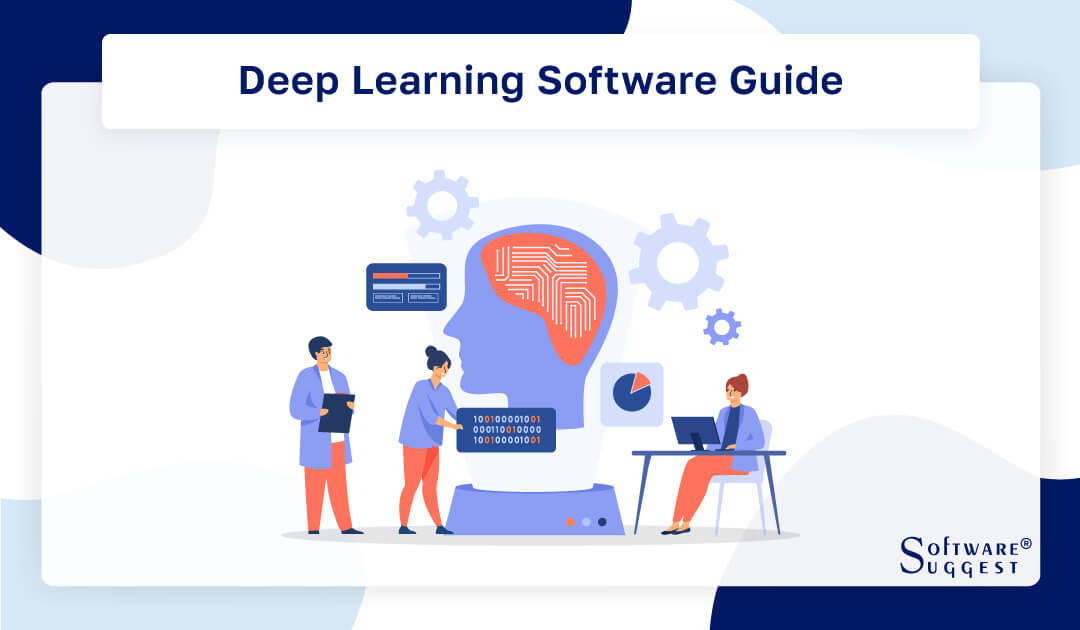
Are you working in the field of artificial intelligence? Then, it must be tough to pick the right deep learning software. It doesn't matter if you're a pro at working with data or just starting to explore deep learning; this guide is here to help you like a trusty compass. Through rigorous evaluation of diverse solutions, we've compiled a tailored list that aligns with your specific industry requirements.
In the dynamic field of deep learning, the choice of deep learning tools is crucial. It empowers your neural networks, enhancing the excellence of your AI projects. Our guide offers straightforward suggestions, user-friendly features, and practical insights, enabling you to make smart choices. Begin your exploration today and find the perfect deep learning programs to elevate your deep learning endeavors.
What Is Deep Learning?
Deep learning, a subset of artificial intelligence, involves training artificial neural networks with multiple layers of interconnected nodes to learn from extensive datasets. By mimicking the human brain's information processing, these networks refine their understanding through iterations. Thus enabling tasks like image recognition, speech processing, and autonomous driving.
In essence, deep learning empowers machines to comprehend complex patterns and make informed decisions, making it pivotal in today's AI-driven world. Its ability to handle intricate and diverse data has made deep learning a cornerstone technology for applications. It ranges from healthcare diagnostics to autonomous vehicles and natural language understanding, shaping the future of numerous industries.
What Is Deep Learning Software?
Deep learning software refers to specialized applications and frameworks designed to facilitate the training and deployment of deep neural networks. Deep learning software tools offer the essential resources and infrastructure for data scientists and developers. It is to craft, train, and employ intricate artificial neural networks. These deep learning models are pivotal for accomplishing tasks such as recognizing images and processing speech.
It also includes natural language processing and autonomous systems, enabling machines to learn from vast datasets and make sophisticated decisions. Deep learning software plays a pivotal role in advancing artificial intelligence applications across various industries. Thus making it a fundamental component of modern AI technology stacks.
How Does Deep Learning Work?
Deep learning is a subset of machine learning, a field within artificial intelligence (AI). In recent years, it has been incredibly popular and successful, especially when it comes to tasks like natural language processing, autonomous driving, picture and speech recognition, and more. Let's delve into how deep learning works.
-
Neural networks
Central to the deep learning framework lie artificial neural networks (ANNs), comprising an input layer, hidden layers, and an output layer. These connected nodes are often referred to as neurons or perceptrons.
-
Learning from data
In the feedforward phase, data enters the network, and each neuron in the hidden and output layers processes it through weighted sums and activation functions. In the backpropagation phase, the network compares the output to the target, calculates the error, and iteratively adjusts weights from output to input for model training until convergence.
-
Depth and representation learning
The term "deep" in deep learning refers to the presence of multiple hidden layers in the neural network. Deeper networks have the capacity to capture intricate and hierarchical features in data. Deep learning excels at feature extraction and representation learning. This reduces the need for domain-specific expertise in feature engineering and allows the model to adapt to various datasets.
-
Training and learning from big data
Deep learning thrives when supplied with substantial amounts of data. It is data-driven and benefits from large datasets to generalize well. Large computational resources are needed to train a deep neural network on massive data; graphics processing units (GPUs) are frequently used to speed up the process.
-
Applications of deep learning
Deep learning has found applications in numerous domains. In computer vision, deep neural networks can recognize objects, faces, and even diseases in medical images. In natural language processing, they power chatbots, language translation, and sentiment analysis.
In autonomous vehicles, deep learning enables perception and decision-making. The versatility and adaptability of deep learning make it a fundamental technology in the AI landscape.
Benefits Of The Best Deep Learning Software Tools
The best deep learning software has become indispensable in the world of artificial intelligence. These AI software offer a multitude of benefits that contribute to their widespread adoption and success.
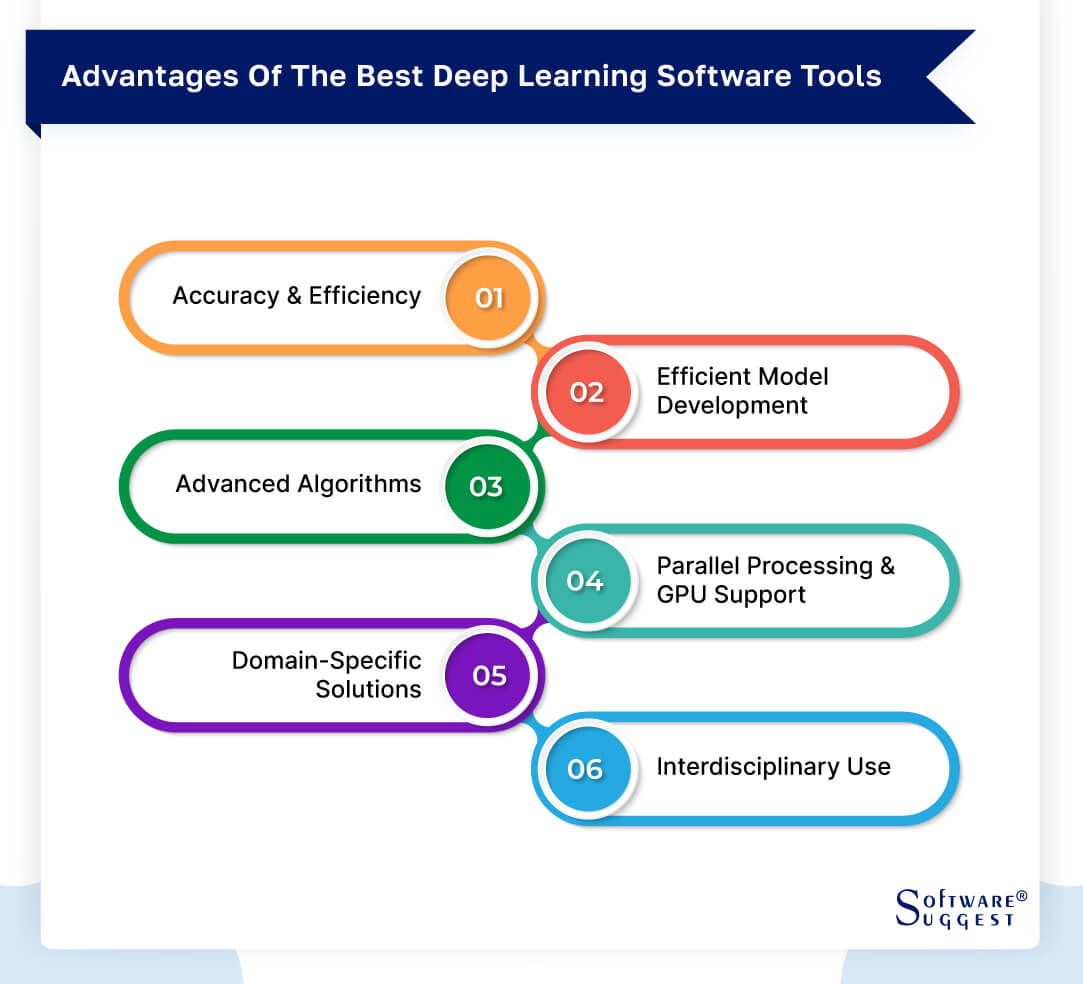
-
Accuracy & efficiency
Training deep learning models offer a significant advantage in improving model accuracy. Deep neural networks excel in recognizing complex patterns and relationships within data, leading to more precise predictions and classifications. Moreover, these technologies are proficient at handling large datasets, making them well-suited for various applications.
-
Efficient model development
The best deep learning software streamlines the model development process. These tools often come equipped with user-friendly interfaces and pre-built modules that simplify the creation, training, and evaluation of neural networks. It leads to faster innovation than the human brain and model deployment.
-
Advanced algorithms
Leading ML software incorporates state-of-the-art algorithms and architectures. Convolutional neural networks (CNNs) are utilized for image analysis, recurrent neural networks (RNNs) for sequential data, and transformers for natural language processing tasks.
-
Parallel processing and GPU support
Deep learning software tools harness the power of parallel processing, taking full advantage of multicore processors and graphics processing units (GPUs). This parallelism accelerates training times, enabling deep neural networks to process data and learn patterns more swiftly.
GPU support is particularly beneficial for large-scale deep learning technology projects, enabling practitioners to train complex models efficiently.
-
Domain-specific solutions
The best deep learning software often offers domain-specific solutions and convolutional neural networks. This means that in fields such as healthcare, finance, and natural language processing, practitioners can leverage pre-existing models that have been fine-tuned for specific tasks.
-
Interdisciplinary use
Distributed deep learning library software is highly versatile and applicable across a wide range of disciplines. Deep learning technologies are useful in many different areas, whether it is for medication development, picture generation, fraud detection, or climate prediction.
They are incredibly useful tools for data scientists, engineers, and researchers in many different sectors because of their scalability and adaptability.
Features Of The Best Deep Learning Software
Selecting the best deep learning tool is pivotal for achieving optimal results in your AI projects. The top-tier software packages offer a range of features that can greatly enhance your deep learning endeavors.
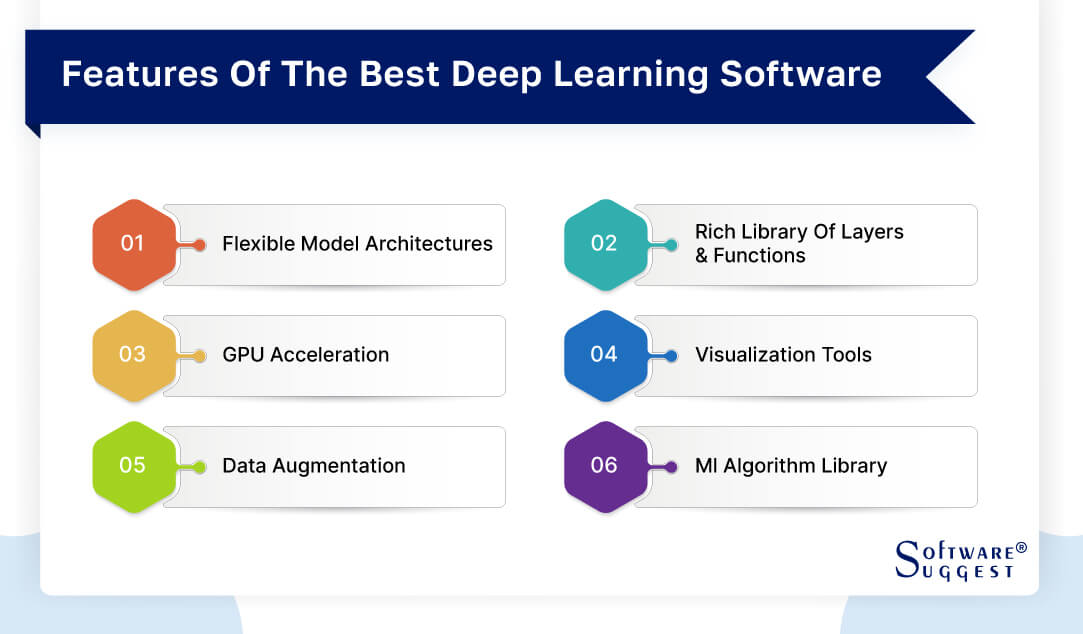
-
Flexible model architectures
Leading deep learning software provides flexibility in creating model architectures. It means you can design neural networks with various layers and configurations to suit your specific tasks. Whether you need a simple feedforward network or a complex convolutional or recurrent network, the best software empowers you to customize your models.
-
Rich library of layers and functions
A key feature of top-notch deep learning software is a comprehensive library of layers and functions. These libraries come equipped with pre-built modules for common deep learning operations. These are convolution, pooling, and recurrent layers, as well as activation functions like ReLU, sigmoid, and tanh. This abundance of pre-defined components simplifies model construction and saves time.
-
GPU acceleration
Efficient computation is a hallmark of the best deep learning software. They utilize the capabilities of graphics processing units (GPUs) to speed up the training process. GPUs excel at parallel processing, which substantially decreases the time needed for training deep neural networks. This becomes especially crucial when handling extensive datasets and intricate models.
-
Visualization tools
Visualization is a critical aspect of model development and debugging. Leading deep learning software packages offer visualization tools that allow you to inspect model architectures, visualize training progress, and explore intermediate feature representations. These visual insights help you understand how your model is learning and performing.
-
Data augmentation
Data augmentation is a method employed to artificially expand training datasets by implementing modifications to existing data. Premium deep learning software frequently features integrated data augmentation capabilities. These resources empower you to produce augmented data, thereby improving the overall adaptability and resilience of the model.
-
ML algorithm library
In addition to deep learning capabilities, top-tier software often includes a library of machine learning algorithms. This broadens the software's utility, allowing you to explore traditional machine learning techniques alongside deep learning. It's especially beneficial when you need to combine different approaches to tackle complex problems.
Methods For Creating Strong Deep Learning Models
Building robust and high-performance deep learning models involves employing various methods and strategies that go beyond just selecting the right architecture. These methods ensure that your models are accurate, efficient, and ethically sound.
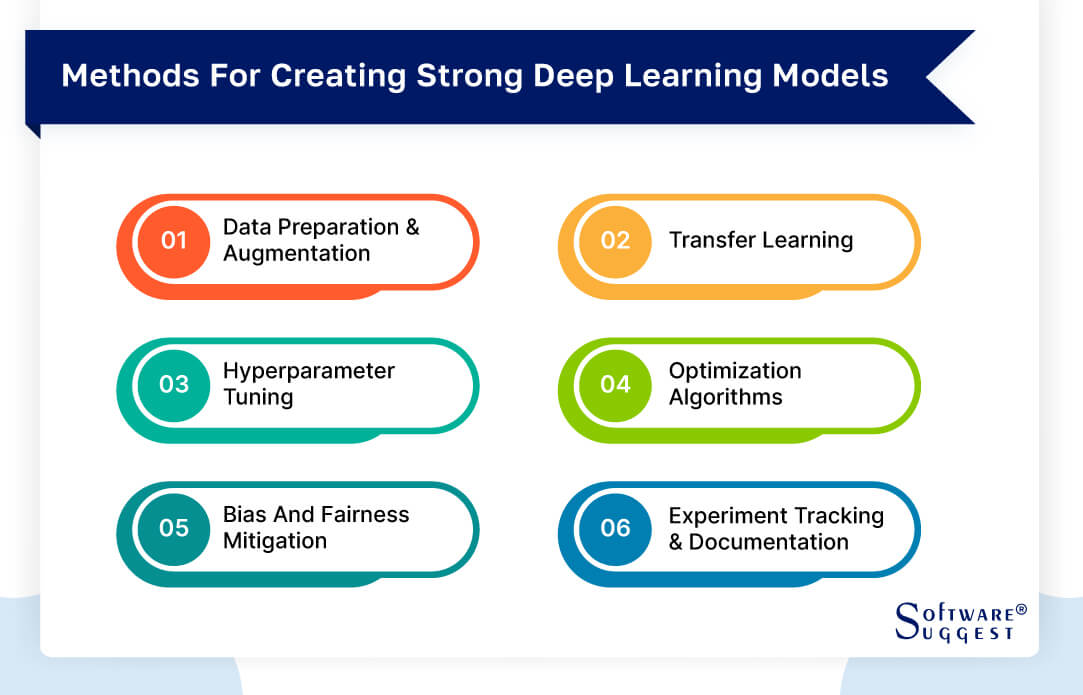
-
Data preparation and augmentation
Effective data preparation is foundational to model success. This involves cleaning, formatting, and preprocessing raw data to ensure it's suitable for training. Data augmentation is another critical step, where you artificially increase your dataset's size by applying transformations to existing data, such as image rotation or cropping.
-
Transfer learning
Transfer learning proves to be a valuable method that harnesses pre-existing models to enhance the performance of your model for a particular task. Using a smaller, task-specific dataset, you can fine-tune a model trained on a large dataset for your particular purpose. This approach conserves time and computational resources, frequently delivering outstanding outcomes.
-
Hyperparameter tuning
Optimization is required for a number of hyperparameters in deep learning models, including learning rates, batch sizes, and layer sizes. The process of hyperparameter tuning entails methodically determining which hyperparameter combination will maximize the model's performance.
-
Optimization algorithms
An important consideration in training deep learning models is the optimization method selection. Adam, RMSprop, and stochastic gradient descent (SGD) are examples of common optimization techniques. Selecting the most appropriate algorithm for your specific problem and monitoring its performance during training is vital to ensure efficient convergence.
-
Bias and fairness mitigation
Addressing bias and fairness is becoming increasingly important in AI and deep learning. It's essential to evaluate and mitigate biases in your data and model predictions to ensure fair and equitable outcomes. Techniques like re-sampling, re-weighting, and adversarial training can help reduce bias and enhance fairness in model predictions.
-
Experiment tracking and documentation
Proper experiment tracking and documentation practices are often overlooked but are crucial for model reproducibility and collaboration. Tools like version control systems, experiment management platforms, and detailed documentation of your experiments can help you keep track of changes.
How To Select The Right Deep Learning Software?
Selecting the best deep learning software is an important choice that will have a big impact on how well your AI projects work out. The following elements should be taken into account when making a decision so that it fits your demands and objectives.
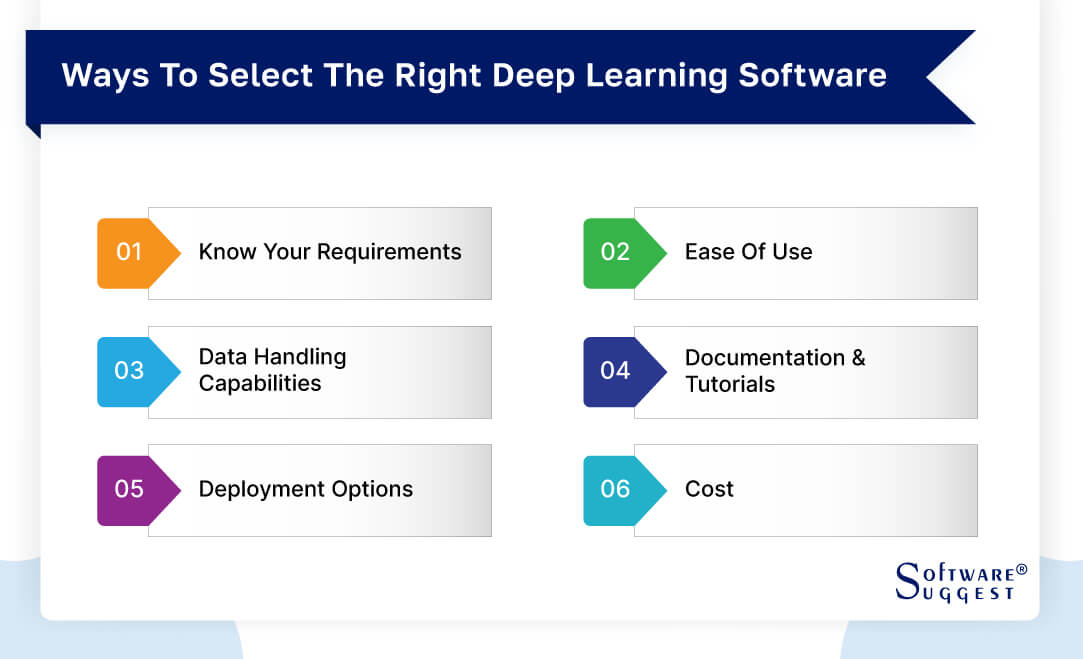
-
Know Your requirements
Start by clearly defining your project's requirements and objectives. Reckon the type of tasks you need to accomplish, such as image recognition, natural language processing, or recommendation systems. Determine the scale of your project, the complexity of your data, and any specific algorithms or models you plan to use.
-
Ease of use
An important consideration is user-friendliness, particularly if you're new to deep learning. Seek for software with a user-friendly interface and efficient workflows. Certain tools facilitate the design, training, and evaluation of models by offering graphical interfaces and drag-and-drop functionality.
-
Data handling capabilities
Deep learning heavily relies on data. Ensure that the software you choose can handle your data effectively. It should support various data formats, offer data preprocessing capabilities, and integrate seamlessly with your data storage and retrieval systems.
-
Documentation and tutorials
Comprehensive documentation and tutorials are invaluable, especially for users at different skill levels. Choose software with well-maintained documentation, including guides, API references, and sample code. Access to tutorials and online communities can be immensely helpful in getting started and troubleshooting issues.
-
Deployment options
Consider how you plan to deploy your deep learning models. Certain software offers deployment choices for on-premises servers, edge devices, and cloud platforms. Examine if the program provides the flexibility to implement models in the setting that best meets the needs of your project.
-
Cost
Budget considerations are vital. Deep learning software varies in terms of licensing models, pricing structures, and available editions. While some tools are available in open-source forms, some call for one-time or subscription payments. Reckon any further costs for storage, support, or computing resources when evaluating the software's cost.
Challenges And Limitations In Deep Learning Software
While deep learning software has revolutionized various industries, it comes with its share of challenges and limitations that practitioners must be mindful of.
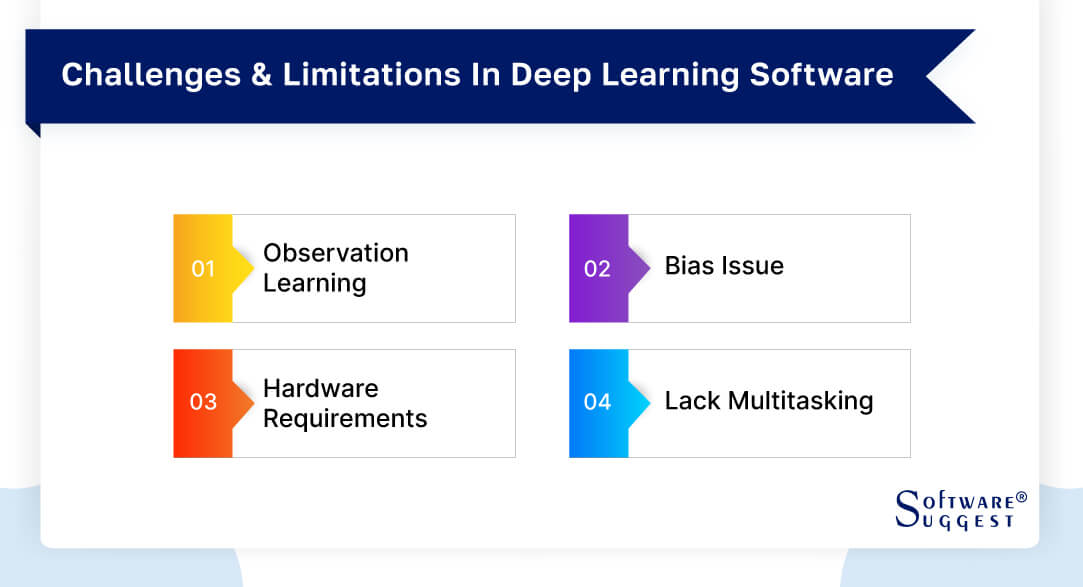
-
Observation learning
Deep learning relies heavily on labeled data for training. Obtaining large, high-quality datasets can be a daunting task, especially in domains where human experts are needed to annotate data accurately. Moreover, the absence of labeled data can limit the applicability of deep learning to new and niche domains.
-
Bias issue
Deep learning models can inadvertently inherit biases present in the training data, leading to biased predictions and outcomes. Addressing bias and fairness in AI models remains a significant challenge, necessitating careful data curation, algorithmic improvements, and ethical considerations.
-
Hardware requirements
Deep learning is computationally intensive, often requiring powerful hardware, such as GPUs or TPUs, to train complex models efficiently. This can be a substantial barrier for individuals or organizations with limited access to such hardware, affecting the scalability and accessibility of deep learning solutions.
-
Lack of multitasking
Workflow Flowcharts focus on representing the specific tasks, decisions, and actions that constitute a particular workflow. They are widely used in project management, outlining the step-by-step progression of tasks and milestones, making it simpler to track and manage project progress.
Latest Market Trends In Deep Learning Software
The deep learning software market is dynamic, with emerging trends shaping the landscape of artificial intelligence. These trends reflect the industry's ongoing evolution and the demand for innovative solutions.
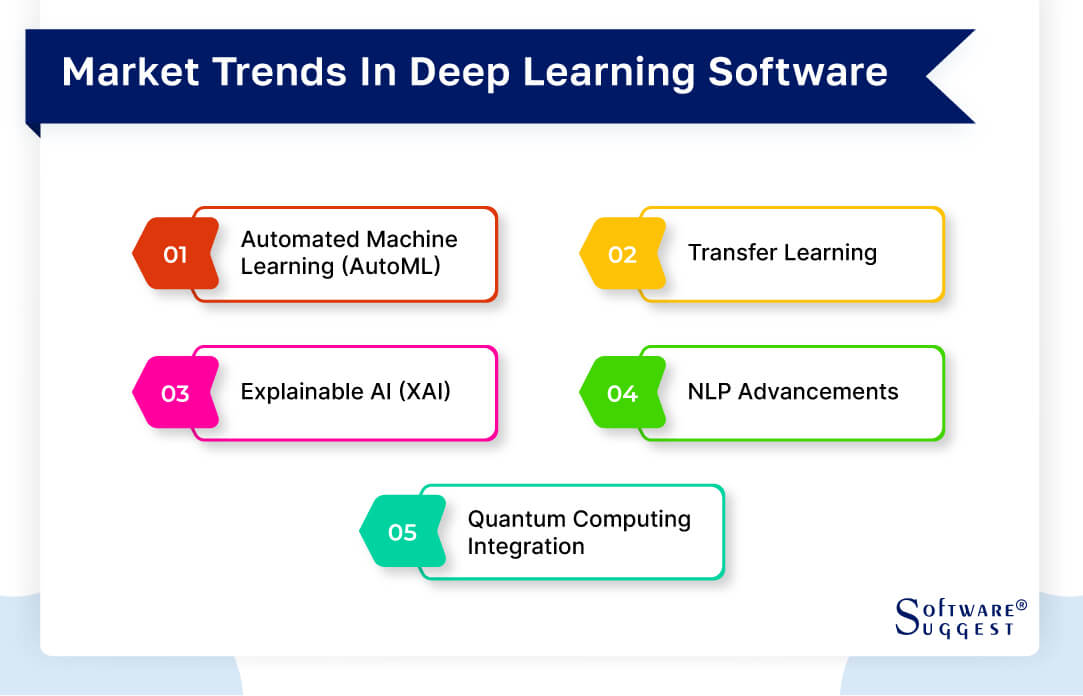
-
Automated machine learning (AutoML)
AutoML is gaining momentum as it simplifies the machine learning process by automating tasks such as data preprocessing, feature engineering, model selection, and hyperparameter tuning. This trend democratizes AI by enabling non-experts to develop machine learning models efficiently.
-
Transfer learning
Transfer learning remains a focal point, allowing models pre-trained on large datasets to be fine-tuned for specific tasks. This method lowers the amount of data needed for training and is hence a desirable choice for a range of applications.
-
Explainable AI (XAI)
There is a growing demand for interpretability and transparency as AI systems get more complicated. The goal of XAI approaches is to increase the accountability and understandability of AI models so that people can justify and have faith in judgments made by AI.
-
NLP advancements
Significant progress is being made in natural language processing (NLP), especially with language models like GPT-3 and BERT. These models enable more accurate and context-aware language understanding, opening up new possibilities in chatbots, language translation, and content generation.
-
Quantum computing integration
Quantum computing is on the horizon, offering immense potential for accelerating deep learning tasks. Integrating quantum computing with deep learning software may lead to groundbreaking advancements in areas like optimization and cryptography.
How Much Does Deep Learning Software Costs?
Depending on the exact software and its characteristics, deep learning software might have widely different prices. Some machine learning software solutions can have monthly costs as high as $1,000, while packages for deep learning software might start at $365.
Conclusion
In short, in the world of deep learning software, selecting the best fit is paramount. Assess your needs, ease of use, data handling capabilities, documentation, deployment options, and cost to make an informed choice. Keep these factors in mind to embark on a successful deep learning journey.
FAQs
Deep learning is a subset of artificial intelligence (AI). AI encompasses a broader range of techniques and technologies, while deep learning focuses specifically on neural networks and pattern recognition.
Deep learning is pivotal because it enables machines to learn and make decisions from data, leading to advancements in various fields, including computer vision, natural language processing, and autonomous systems. Its ability to handle complex patterns and large datasets drives innovation in AI.


















.jpg)



